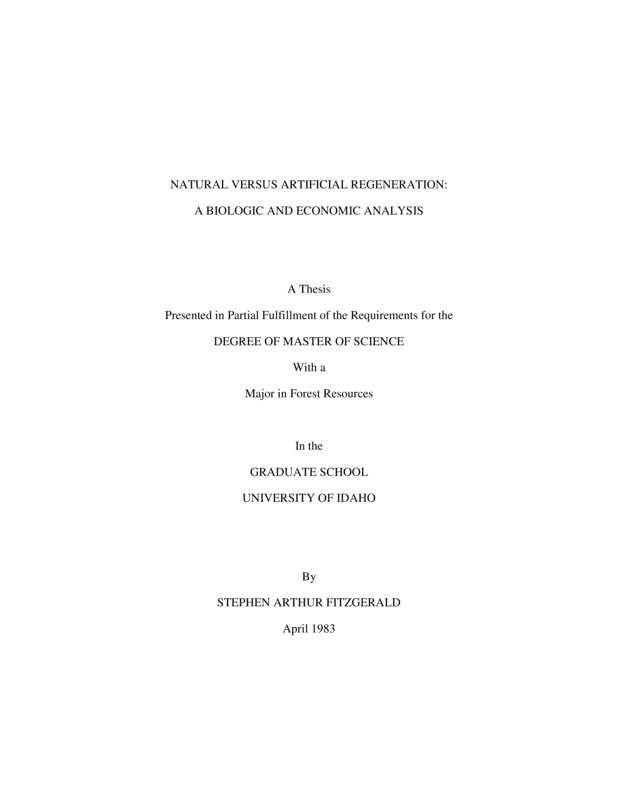PDF PREVIEW
Natural Versus Artificial Regeneration: A Biologic and Economic Analysis Item Info
Download Preview PDF
Please note: PDF file may not be complete document.
- Title:
- Natural Versus Artificial Regeneration: A Biologic and Economic Analysis
- Creator:
- Fitzgerald, Stephen Arthur
- Date Created:
- 1983-04
- Description:
- The potential of natural regeneration using the shelterwood and seedtree harvest-regeneration methods was evaluated for several site and stand conditions in northern Idaho. One seedtree and seven shelterwood cuts were examined and compared with potential plantations on the same sites. Growth and development of natural and artificially regenerated stands were projected using the Prognosis Model for Stand Development. Biological yields were evaluated economically with the Net Present Value (NPV) criterion. The success of natural regeneration was highly dependent upon the habitat type, overwood and regeneration characteristics, and the economic assumptions used in the analysis. For the natural stands on the Thuja/Pachistima habitat type, results showed preferred reforestation method was clearcut and plant to western white pine to maximize NPV. On the Abies/Pachistma habitat type natural regeneration was financially more attractive. Of the five natural stands on this habitat type, four had approximately equal NPV’s to comparable ponderosa pine plantations. Within this habitat type, several tree/stand attributes were desirable for successful natural regeneration. Overwood density, growth, and species composition had a major impact on the overall NPV of the natural stands. Empirical models were developed to quantify desirable overwood characteristics. Variables with proved significant in the models were tree diameter, crown ratio, and competitive status. Similarly, the composition, the amount, and growth of the regeneration had the most significant impact on the overall NPV of the natural stands for a given set of economic conditions. The financial results reported in this study were greatly influenced by the economic assumptions used in the analysis. Financial success of natural regeneration was highly sensitive to the discount rate. Varying stumpage prices influenced the magnitude of NPV but did not change the preferred regime.
- Document Type:
- Thesis
- Library Call Number:
- SD409.F58
- Subjects:
- Flat Creek natural regeneration artificial regeneration economic analysis shelterwood seedtree silviculture
- UIEF Unit:
- Flat Creek
- Location:
- UIEF; Flat Creek
- Latitude:
- 46.851013
- Longitude:
- -116.724478
- Department:
- Department of Forest Resources
- Type:
- Text
- Format:
- application/pdf
Source
- Preferred Citation:
- "Natural Versus Artificial Regeneration: A Biologic and Economic Analysis", UIEF Research Exchange, University of Idaho Library Digital Collections, https://www.lib.uidaho.edu/digital/uief/items/uief_0038.html
Rights
- Rights:
- In copyright, educational use permitted.
- Standardized Rights:
- http://rightsstatements.org/vocab/InC-EDU/1.0/

